Why this resume works
- Highlights industry-specific skills: The applicant’s ability to train apprentices and design custom cabinetry is solid evidence of industry-specific skills, perfect for roles requiring expertise in woodworking and carpentry.
- Quantifies accomplishments: Increasing project completion by 20% and boosting sales by $50K are impressive accomplishments to have on your resume, underlining the applicant’s tangible impact.
- Illustrates problem-solving ability: By implementing safety protocols that reduced incidents by 15%, the applicant illustrates strong problem-solving skills by taking proactive measures in workplace safety.
More Carpenter Resume Examples
Check out more resume examples to understand how to showcase your craftsmanship, project experience, and attention to detail. These samples will help you create a resume that attracts construction employers and suits various carpentry roles.
Entry-Level Carpenter
Why this resume works
- Centers on academic background: The education section, listing a master’s in construction management and a bachelor’s in architecture, shows the applicant’s solid academic foundation important early in your career.
- Puts skills at the forefront: By placing skills like custom woodworking and project management at the top, this resume follows a skills-based resume format, ideal for newcomers.
- Shows digital literacy: There’s some evidence of advanced computer skills that align well with modern workplace demands.
Mid-Level Carpenter
Why this resume works
- Includes a mix of soft and hard skills: The applicant skillfully balances technical expertise in woodworking with interpersonal skills like managing teams effectively and improving project workflows, a well-rounded mix of capabilities.
- Points to measurable outcomes: Highlighting achievements like boosting sales by 20% and reducing costs by 10%, the applicant clearly illustrates their impact on business growth and operational improvements.
- Demonstrates language abilities: With language skills in Spanish, French, and German, the applicant is equipped for for cross-cultural communication with diverse clientele.
Experienced Carpenter
Why this resume works
- Focuses on work history: Using a chronological resume format, the applicant’s work history unfolds seamlessly, showcasing extensive experience and achievements through roles in carpentry and woodworking.
- Lists relevant certifications: By listing certifications like Certified Master Carpenter, the applicant shows their expertise and dedication to continuous learning.
- Emphasizes leadership skills: Genuine leadership abilities shine through as the applicant guides teams to success, achieving cost savings and improving workflow efficiency along the way.
Carpenter Resume Template (Text Version)
Jin Nguyen
Eastside, WA 98008
(555)555-5555
Jin.Nguyen@example.com
Professional Summary
Experienced carpenter with expertise in custom designs and project management. Proven track record in increasing client satisfaction and sales through high-quality craftsmanship. Strong skills in team leadership and safety protocols, ensuring superior results. Native Spanish speaker and certified professional.
Work History
Carpenter
Craftsman Builders Inc – Eastside, WA
January 2023 – December 2024
- Designed custom cabinetry increasing project completion 20%
- Implemented safety protocols reducing incidents by 15%
- Managed a team of 5 carpenters on various projects
Woodworking Specialist
Timberworks LLC – Seattle, WA
January 2021 – December 2022
- Built bespoke furniture leading to K sales increase
- Conducted quality checks ensuring 98% client satisfaction
- Trained 4 apprentices in advanced woodworking techniques
Residential Carpenter
HomeCraft Remodeling – Tacoma, WA
January 2019 – December 2020
- Renovated 12 properties boosting market value by 25%
- Collaborated with architects on design enhancements
- Installed cabinetry and fixtures in high-end homes
Languages
- Spanish – Beginner (A1)
- French – Intermediate (B1)
- German – Beginner (A1)
Skills
- Custom carpentry
- Blueprint reading
- Project management
- Furniture design
- Team leadership
- Safety protocols
- Client communication
- Quality assurance
Certifications
- Certified Professional Carpenter – National Carpentry Association
- Advanced Woodworking Techniques – American Woodworkers Guild
Education
Associate’s Degree Carpentry
Springfield Technical Institute Springfield, Illinois
December 2018
High School Diploma General Studies
Lincoln High School Springfield, Illinois
December 2016
Related Resume Examples
Advice for Writing Your Carpenter Resume
Looking to carve out an impressive resume for a carpenter position? We’ve got you covered!
Dive into our tailored tips on how to write a resume and discover ways to highlight your woodworking skills, hands-on experience, and craftsmanship.
Let’s get started on building the perfect resume together!
Highlight relevant technical skills
For a carpenter, technical skills are key to performing tasks with precision and efficiency. Create a Technical Skills section in your resume to highlight abilities that align with the role’s requirements or incorporate them into your work experience descriptions for added context.
Highlight hands-on expertise such as woodworking, measuring materials accurately, and using power tools like saws, drills, and sanders. If relevant, mention skills related to reading blueprints or understanding building codes since these are often needed for carpentry projects.
In addition to tool usage, carpenters benefit from skills like framing, cabinetry making, finishing surfaces, and installing fixtures. Include knowledge of various materials such as wood types or composite products and techniques. Employers value attention to detail in measurements and craftsmanship to ensure project durability and appearance meet expectations.
When describing these skills in work experience sections, connect them directly to results achieved in past roles. For example, you might explain how your ability to use specialized equipment led to timely completion of projects or improved structural quality. Tailoring your technical skills list helps show you’re ready for challenges specific to carpentry jobs while demonstrating versatility across different tasks involved in the trade.
Example of a technical skills section
- Blueprint reading & interpretation
- Hand tools (saws, chisels, hammers)
- Power tools (drills, routers, sanders)
- Woodworking machinery (planers, jointers, lathes)
- Construction software (AutoCAD, SketchUp)
- Framing techniques and installation
- Cabinet making & millwork
- Finish carpentry & trim work
- Measuring & leveling devices
- Safety protocols & regulations in construction
Soft skills like teamwork, communication, and leadership are just as important as hard skills, even when you work in a technical environment.
Quantify your accomplishments
Quantifying your accomplishments makes it more engaging and informative than just listing what you did every day. By focusing on measurable results, you show how your work made a difference.
What does this mean in practical terms? In the work experience section, make sure to include your job title, employer name, location, and employment dates. Turning duties into achievements can mean highlighting how much time you saved by using efficient methods or stating the percentage of cost reduction achieved through smart material choices.
Using action verbs and numbers creates a resume that highlights results rather than just tasks. For instance, instead of saying “built cabinets,” say “constructed 50 custom cabinets within three weeks.” This kind of detail helps hiring managers quickly see your impact and skills as a carpenter.
5 carpenter work history bullet points
- Constructed and installed custom cabinetry and furniture, increasing client satisfaction scores by 25%.
- Managed the assembly of structural frameworks for residential projects, completing tasks 10% ahead of schedule.
- Collaborated with contractors to streamline material usage, reducing project costs by $5,000 per build.
- Restored historical woodwork in heritage properties, preserving architectural integrity on six major sites.
- Trained a team of 3 apprentices in advanced carpentry techniques, boosting overall workshop productivity by 15%.
Need some inspiration for your resume? Check out professional resume examples to see what makes a great resume and get ideas for your own.
Write a powerful professional summary
When crafting your resume’s introduction, you’ll need to decide between a summary or an objective statement.
A professional summary is typically best for those with experience. It’s a brief paragraph that highlights your experience, skills, and accomplishments, aiming to present your professional identity and the value you bring to an employer.
Resume objectives differ by focusing on career goals instead of past achievements. They’re ideal for entry-level job seekers, career changers, or those with employment gaps. An objective tells employers “what I aim to contribute,” while a summary communicates “what I’ve achieved.”
We’ll next provide examples of both summaries and objectives tailored to various industries and experience levels. This will help demonstrate how each can be effectively used depending on where you are in your career journey.
Carpenter resume summary examples
Entry-level
Recent graduate with an associate degree in carpentry from a technical college, equipped with foundational skills in woodworking, blueprint reading, and construction safety. Completed internships that provided hands-on experience with residential framing and finish carpentry. OSHA certified and eager to contribute craftsmanship skills to a dynamic team environment.
Mid-career
Skilled carpenter with over 7 years of experience in commercial and residential construction projects. Proficient in cabinet installation, custom millwork, and structural repairs. Demonstrated ability to lead small teams on job sites while maintaining high standards for quality and efficiency. Recognized for completing projects on time and within budget.
Experienced
Veteran carpenter with 15+ years of expertise in high-end residential remodeling and project management. Specializes in historical restoration, custom cabinetry design, and sustainable building practices. Strong leadership skills demonstrated by managing large-scale crews across multiple sites, resulting in increased productivity and client satisfaction. Holds certifications in green building techniques.
Carpenter resume objective examples
Entry-level
Aspiring carpenter with hands-on training in woodworking and construction techniques, eager to start a career in carpentry by contributing craftsmanship and attention to detail to residential and commercial projects. Committed to learning from experienced professionals and developing skills in building structures that meet quality standards.
Career changer
Dedicated professional transitioning into carpentry from a background in mechanical engineering, bringing strong problem-solving abilities and technical knowledge of tools and materials. Excited to contribute innovative solutions and precise workmanship to a team focused on constructing durable and aesthetically pleasing structures.
Entry-level
Passionate individual with coursework in carpentry fundamentals seeking an entry-level position where practical skills in measuring, cutting, and assembling can be used. Eager to work collaboratively on diverse projects while gaining experience in various aspects of the trade, from framing walls to installing cabinetry.
Choose a resume template with clear sections and simple fonts to make your skills and experience stand out. Avoid too many colors or graphics so recruiters can read it easily.
Showcase your credentials
Listing your credentials like certifications, licenses, and specialized training is critical in carpentry. Certifications show that you have the skills and knowledge needed to do the job well. In technical fields, having these can help you stand out from others.
If you have at least one major credential, it’s a good idea to make a special section for them. Here are some of the credentials we tend to see on carpenter resumes:
- OSHA 10-Hour Construction Safety Certification
- Certified Carpenter (CC) through NCCER
- Journeyman Carpenter License
- First Aid/CPR Certification
- Forklift Operator Certification
Creating this section can be an extra boost along with your education details. It shows employers that you’re ready for the job and serious about improving your skills. This makes it easier for them to trust in what you can do.
Example of a certifications section
Journeyman Carpenter Certificate
Issued by: United Brotherhood of Carpenters (UBC)
Issued 2022
OSHA 30-Hour Construction Safety Certification
Issued by: Occupational Safety and Health Administration (OSHA)
Expires 2025
First Aid/CPR/AED Certification
Issued by: American Red Cross
Issued 2023
LEED Green Associate
Issued by: Green Business Certification Inc. (GBCI)
Expires 2024
Forklift Operator Certification
Issued by: National Safety Council
Issued 2021
Choose a chronological resume format if you have steady work history in your field, but opt for a functional or combination format if you’re changing careers, have employment gaps, or want to emphasize skills over job titles.
Salary Insights for Carpenters
Understanding salary data can guide you in making smart choices about your career path or moving to a new place. Check out the U.S. Bureau of Labor Statistics for more information. More details are provided below.
Top 10 highest-paying states for carpenters
Carpenters earn varying salaries across the United States, with a national average of $49,552. The table below highlights the states where carpenters command the highest compensation.
Our salary information comes from the U.S. Bureau of Labor Statistics’ Occupational Employment and Wage Statistics survey. This official government data provides the most comprehensive and reliable salary information for writers across all 50 states and the District of Columbia. The figures presented here reflect the May 2025 dataset, which is the most recent available as of this publication.
| State | Average Salary |
|---|---|
| Arkansas | $59,390 |
| New Jersey | $58,230 |
| Maryland | $58,420 |
| New York | $57,910 |
| Massachusetts | $55,230 |
| Connecticut | $55,960 |
| Vermont | $54,950 |
| Rhode Island | $54,870 |
| Nevada | $53,300 |
| . Virgin Islands | $53,480 |
FAQ
Do I need to include a cover letter with my carpenter resume?
Yes, adding a cover letter to your carpenter resume can be beneficial and make you stand out from other applicants.
Cover letters offer a chance to showcase your unique skills and experiences in carpentry that match the job you’re aiming for, like expertise in custom cabinetry or large-scale construction projects.
If the company focuses on eco-friendly building or historical restoration, you can share any relevant experience or interest you have in those areas.
Consider using tools like our Cover Letter Generator to create a compelling cover letter that complements your resume with expert advice and suggestions.
Also, checking out cover letter examples tailored to skilled trades can provide more inspiration and ensure your application is well-rounded and impactful.
How long should a carpenter’s resume be?
For most carpenters, especially if you have less than 10 years of experience, a one-page resume is typically ideal. Focus on key skills like woodworking, knowledge of tools, and hands-on experience in construction projects.
If you’ve accumulated extensive experience or specialized certifications, extending to a two-page resume can be appropriate. This will allow you to include more relevant details that highlight your craftsmanship, ability to read blueprints, and safety standards compliance. Prioritize recent projects or roles showcasing your expertise in carpentry work.
To tailor your resume length effectively for your career stage, explore resources on how long a resume should be for more detailed guidance.
How do you write a carpenter resume with no experience?
If you’re new to carpentry and lack professional experience, emphasize the skills and training that make you a strong fit for entry-level roles. Here are some tips on how to write a resume with no experience:
- Emphasize relevant skills: List practical skills such as knowledge of tools, ability to read blueprints, attention to detail, and problem-solving abilities. Even if these were developed through personal projects or hobbies, they are valuable.
- Showcase education and training: Include any carpentry courses you’ve taken, whether in high school, vocational training programs, or community college. Mention any certifications or safety training like OSHA.
- Include related experiences: If you’ve had jobs in construction or home improvement retail where you learned about materials or customer interactions, include those roles and what carpentry-related tasks you performed.
- Highlight projects: Discuss personal projects or volunteer work that required carpentry skills. Describe what you built or repaired, the tools used, and any challenges overcome.
Rate this article
Carpenter
Additional Resources
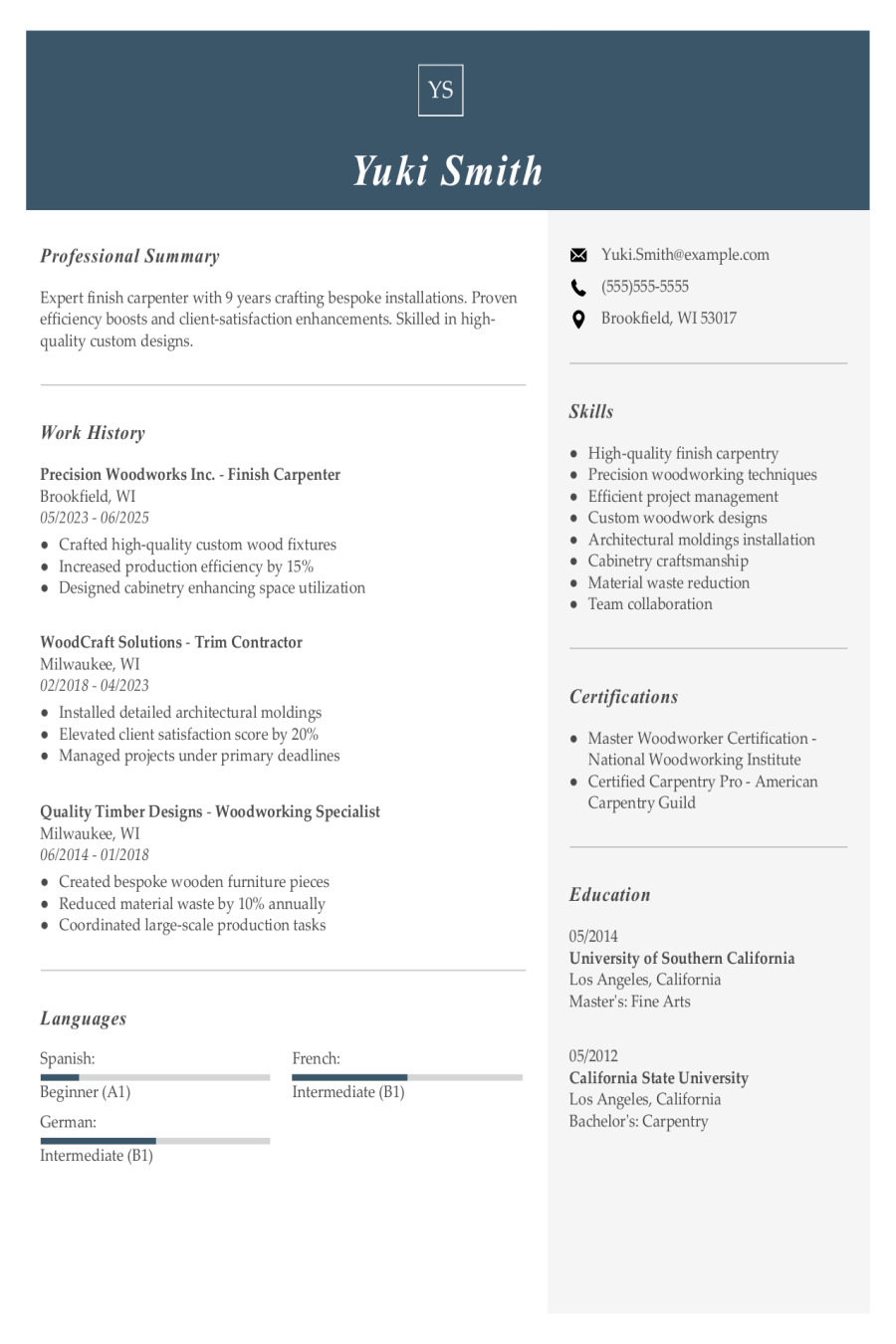
Finish Carpenter Resume Examples & Templates for 2025
A finish carpenter resume should do more than list woodworking tasks. Use these examples and tips to show your craftsmanship, attention to detail, and ability to create polished pieces that
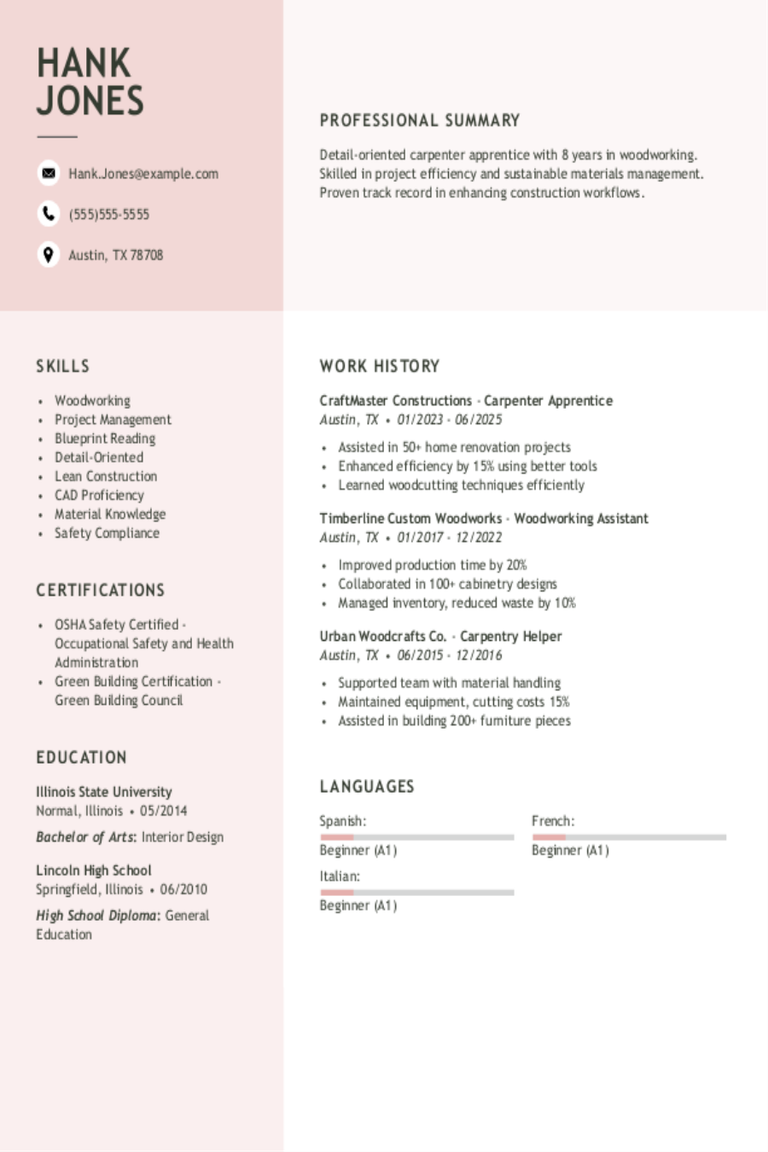
Carpenter Apprentice Resume Examples & Templates for 2025
Your carpenter apprentice resume needs to show how you work with tools, follow plans, and assist carpenters. Learn how to highlight your expertise clearly with our examples and tips.Build my
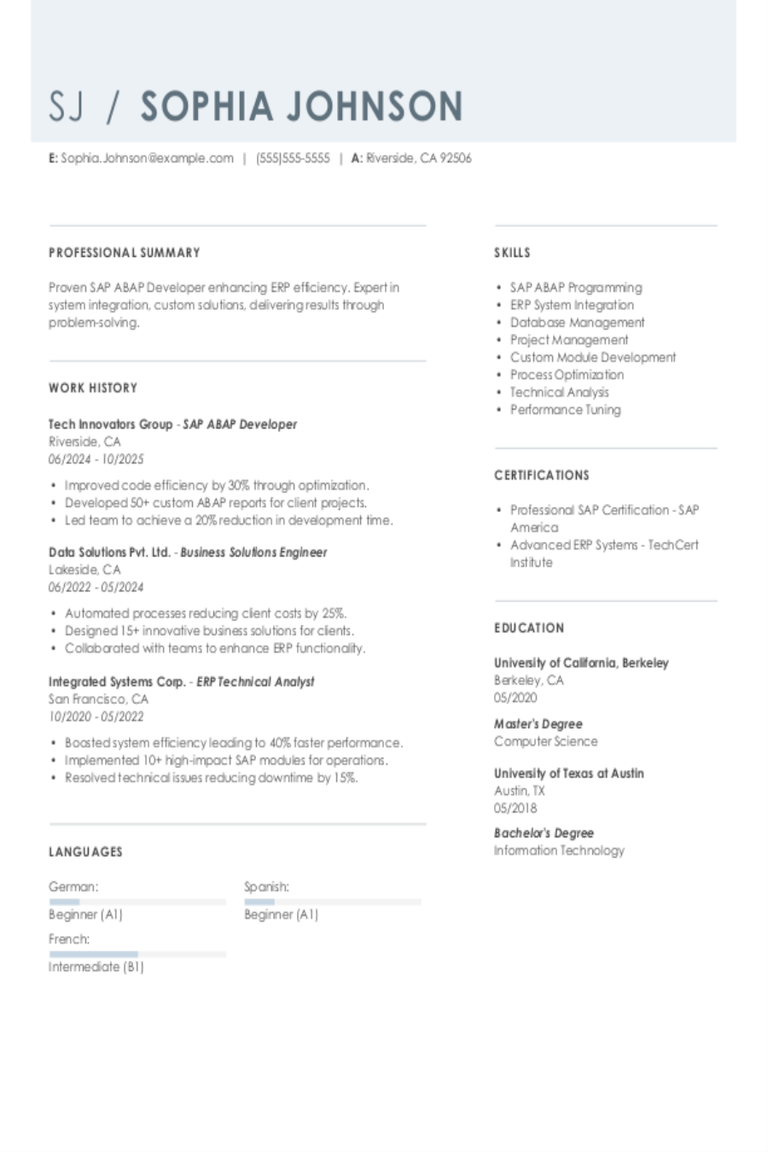
SAP ABAP Developer Resume Examples & Templates for 2025
Explore SAP ABAP developer resume examples and tips to learn how to spotlight your skills in coding, debugging, and system enhancements to stand out to hiring managers.Build my resumeImport existing
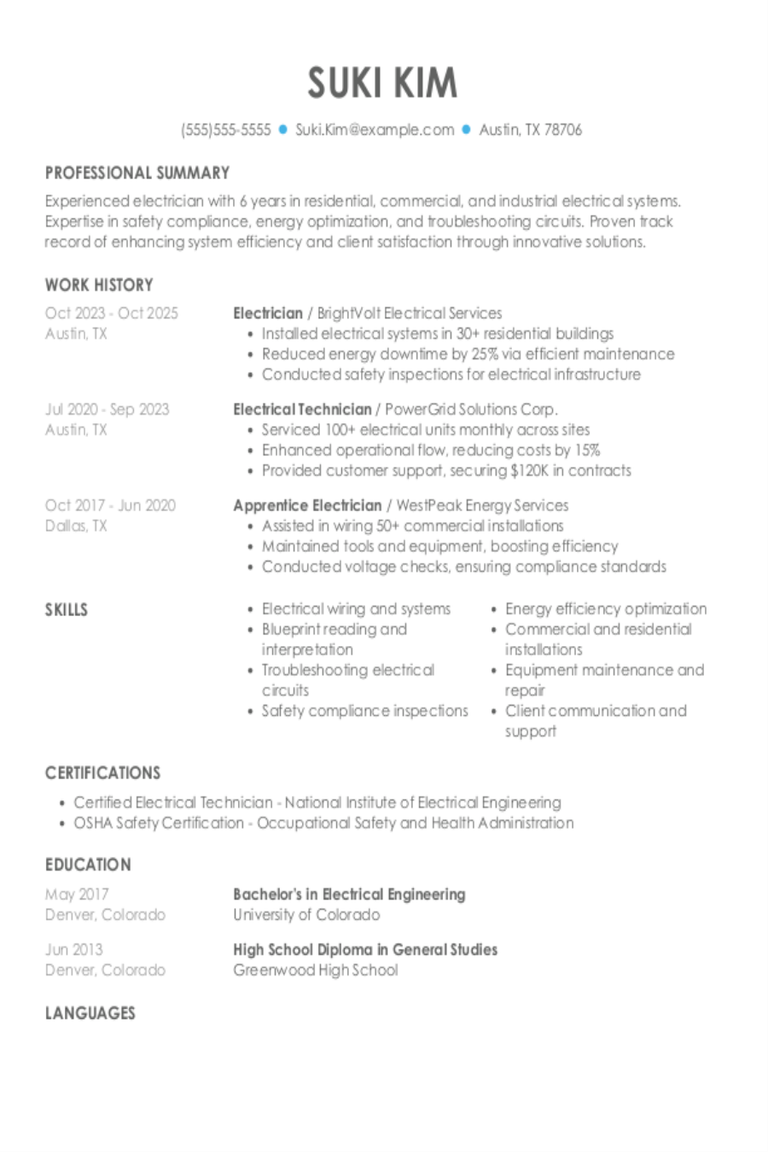
Electrician Resume Examples & Templates for 2025
Explore electrician resume examples to learn how to spotlight your wiring, troubleshooting, and safety skills. See how to emphasize your knowledge of electrical codes and highlight your experience across various
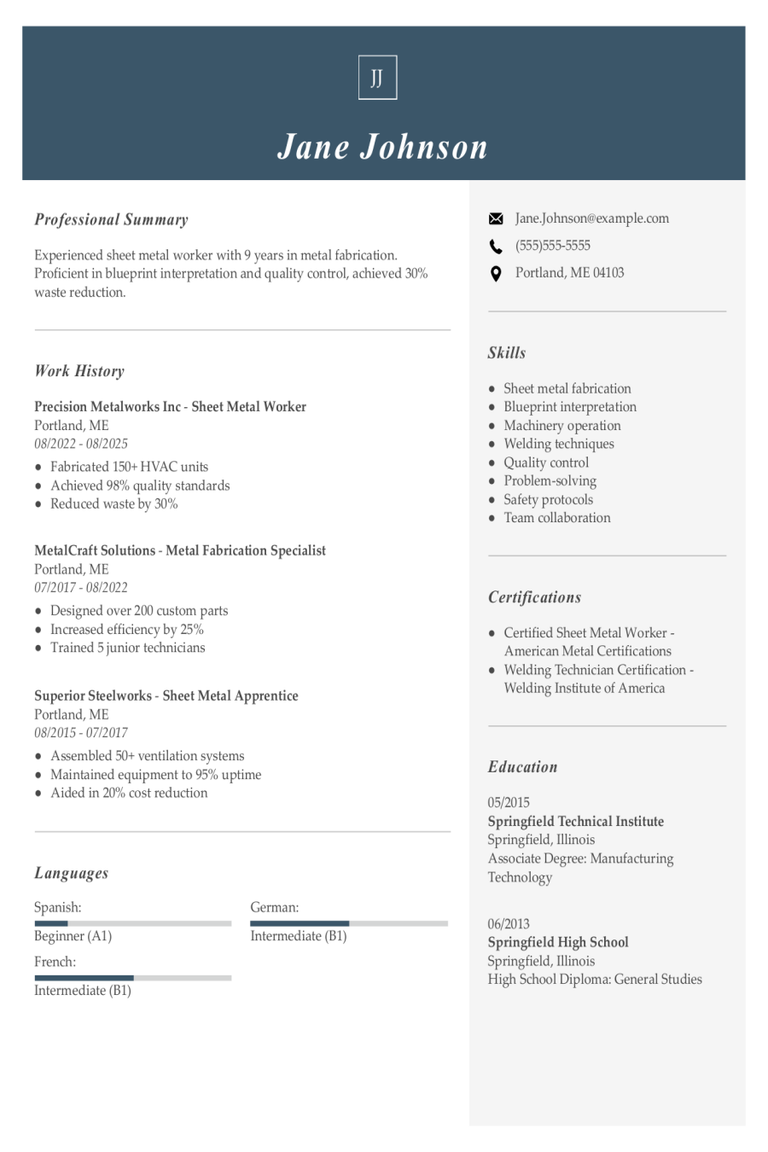
Sheet Metal Worker Resume Examples & Templates for 2025
Browse sheet metal worker resume examples and tips to learn how to highlight your hands-on experience and problem-solving abilities to stand out to recruiters and hiring managers.Build my resumeImport existing

Landscaping Resume Examples & Templates for 2025
Explore landscaping resume examples to see how to showcase your gardening and design skills. Learn how to highlight your experience with plants, tools, and outdoor projects to catch the eye
